Content strategy triage
Who lives? Who dies? Who do you fight to save?
This article is a summary of a presentation first delivered October 21, 2015, at LavaCon in New Orleans.
Triage is a medical concept. If you have a large number of patients flooding in for treatment, you use triage to decide who gets treated first (or at all). Patients are color-coded as follows:
- Red (immediate): Need immediate treatment.
- Yellow (delayed): Need treatment, but can wait.
- Green (minor): Can wait longer than yellow.
- Black (deceased): either deceased or cannot survive their injuries.
If you think this is a bit morbid, you’re right. If you immediately wonder how to combine the concept of triage with content strategy, read on!
In theory, you want to find the perfect project in which you have high visibility, high return on investment (ROI), and low risk.
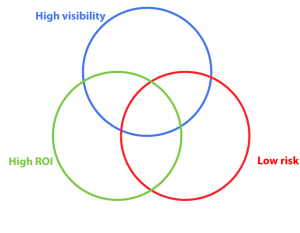
Content strategy, the theory
The reality is that you are probably going to have to settle for two out of three:
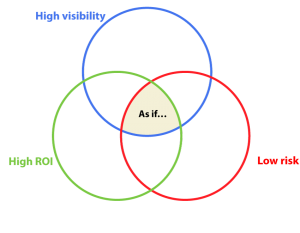
Content strategy, in practice
We divide content strategy efforts into three broad phases:
- Pilot
- Main effort
- Ongoing effort
For a pilot project, you want high visibility and low risk. This maps to red triage–do it immediately!
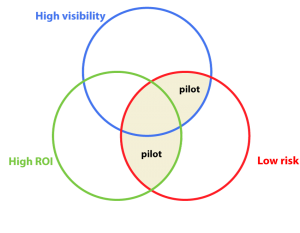
Ideal pilot project is high visibility and low risk. High ROI and low risk is acceptable.
The purpose of a pilot project is survive and advance.
Pilot projects do not need to prove cost savings, or show huge improvements. They are intended to convince the Money People that your content strategy has merit, and that they should continue to invest in it. Therefore, the ideal pilot is the smallest, easiest possible project that will gain momentum for the overall effort. A high-visibility improvement that is easy to achieve is a good choice.
After the pilot phase, you move into the main phase of the project. Here, you want to focus on high-impact projects. You take a few more risks because you expect a high ROI. These projects should focus on visibility and ROI. This is the yellow triage tag; things that are important, but can wait a little while.
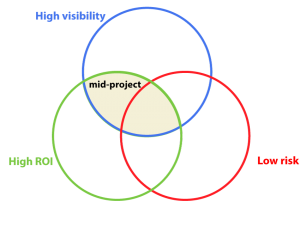
The intersection of visibility and ROI is where you find the main project effort.
If you look at content strategy over time, you can see a pattern emerging. Early on, you need low risk and high visibility. Later, you focus more on ROI. You can also gradually increase the complexity of your projects as your content strategy team gains experience and knowledge.
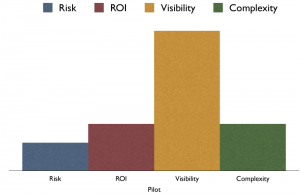
For a pilot project, you need high visibility and low complexity.
You can gradually increase the risk of your projects and the overall complexity as your team gains knowledge and experience.
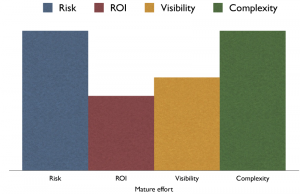
As you gain content strategy experience, you can increase the complexity of your projects.
Content strategy triage helps you assess your projects. Measure the following factors:
- Risk
- ROI
- Visibility
- Complexity
Map each project against these factors, and you will be able to determine which projects should be done early on and which can (and should) wait until you gain more experience.
One of the keys is to figure out what sort of projects should be black-tagged. They may or may not be dead already, but you cannot save them. What sort of content strategy challenges might cause you to just walk away instead of trying to fix it and, as a result, not saving a bunch of other content strategy patients on whom you could have spent your resources instead??


